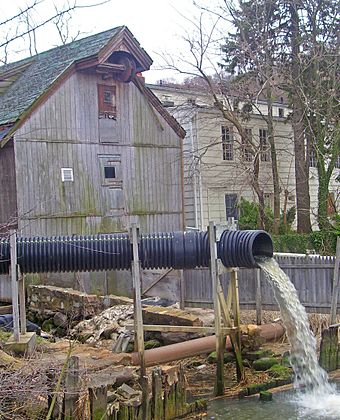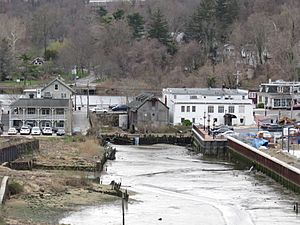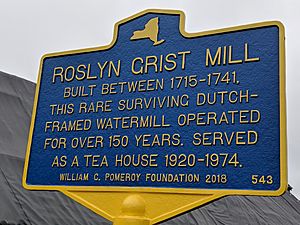Roslyn Grist Mill facts for kids
|
Roslyn Grist Mill
|
|

Rear elevation of mill, with modern
culvert, during 2008 renovations. |
|
| Location | Roslyn, NY |
|---|---|
| Nearest city | Glen Cove |
| Built | ca. 1715–1741 |
| MPS | Roslyn Village Multiple Resource Area |
| NRHP reference No. | 86002638 |
Quick facts for kids Significant dates |
|
| Added to NRHP | October 2, 1986 |
The Roslyn Grist Mill is a very old building located in Roslyn, New York, in the United States. It was built a long time ago, likely between 1715 and 1741. This mill is special because it's one of the few remaining commercial buildings from the time when the Dutch settled in America. In 1986, it was added to both the National Register of Historic Places and the New York State Register of Historic Places. Today, the Roslyn Landmark Society is working to fix it up. Their plan is to turn it into a museum where people can learn about its history.
Contents
Exploring the Mill's Structure
The Roslyn Grist Mill is a two-and-a-half-story building. It is about 50 feet long and 25 feet wide. The original structure was made with strong wooden beams and posts. This way of building, called timber framing, was a bit different from how buildings were made in Europe back then. Now, the outside of the mill is covered with wooden boards called weatherboard.
On the west side of the mill, there is a smaller one-and-a-half-story section. This part is located right above the mill race, which is the channel where water flows to power the mill. North of the mill is a pond. This pond's water eventually flows into Long Island Sound.
Over the years, the ground floor of the mill has changed. It used to be about 12 feet below street level. This happened because of the tides and changes made to the building's foundation. At the very top of the mill, in the attic, there is a large double door. It uses a hook-and-pulley system to open. The windows on the mill are not placed in a regular pattern. Some were added later, and others were covered up. As of 1986, some of the original milling equipment, especially the large gears, were still inside the building.
A Look Back at the Mill's History
A gristmill is a place where grain is ground into flour. There has been a gristmill on this spot since the early 1700s. John Robeson built the first one. Later, Jeremiah Williams bought the land. People believe he built the current mill sometime between 1715 and 1741.
In 1758, Hendrick Onderdonk became the owner. He already owned two paper mills in the area, which was then called Hempstead Harbor. Onderdonk ran the gristmill very well and made a good profit. A famous visitor, George Washington, even mentioned the mill in his diary after he visited the area in 1790.
The Onderdonk family sold the mill in 1801 to Daniel Hoogland and Abraham Coles. Then, in 1849, Joseph Hicks bought it. His family continued to operate the mill until 1916. After that, they changed its use. They turned it into a tea house and a museum. This continued until 1975, when the Nassau County parks department took over the property.
Restoring the Mill in the 2000s
While Nassau County owned the mill, the building was empty for a long time. No one could find a new use for it, and it kept falling apart.
In the 2000s, people in Roslyn worked to get the county to start fixing the mill. This restoration project is expected to cost about $2 million. The money comes from the county, the village, and donations from the community. As part of the project, the mill's ground floor was raised back up to street level. Once the work is finished, the county will give the mill to the village. The Roslyn Landmark Society will then run it as a museum. It will teach visitors about the water-powered industries, like Onderdonk's mills, that were once common in the village.
In 2020, during the restoration work, something exciting was found. Workers discovered a time capsule hidden in concrete. This capsule was from an earlier restoration that happened in 1917. George Gorski, a carpenter working on the mill, found a small milk bottle. It was from a company called Alex Campbell Milk Co., which no longer exists. Inside the bottle were four old coins. These included a Civil War Army & Navy token from 1863, an Indian head penny from 1881, a Haitian 20 centimes coin from 1863, and another Indian head penny from 1905.
There were also two letters. One letter was in English but was hard to read. The other was in Italian, written by an artisan named Romolo Caparelli from Pico, Italy. A professor from Stony Brook University translated the Italian letter. It will be shown at the mill when the restoration is complete. The other letter was from Steven Speedling, a builder from Roslyn. He was a descendant of a Hessian soldier who fought in the American Revolution. His letter listed the workers who helped with the 1917 restoration.
More to Explore
- List of tide mills on Long Island
- National Register of Historic Places listings in North Hempstead (town), New York




